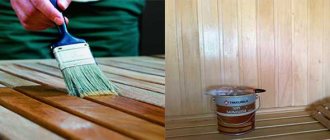When treating steam room surfaces, bath and sauna varnish is often used. This is done to establish a good microclimate in the room, because any chemical product contains harmful substances.
Treated wood retains its beneficial qualities for a long time and tolerates the effects of external natural factors well. It is worth considering in detail how to choose a suitable impregnation, and also read real reviews about varnishes for baths and saunas Neomid and Eurotex.
What is better bath varnish or impregnating oil?
Both types of materials are quite popular in folk or amateur “sauna building”. A wooden bathhouse building must be protected from water vapor and fungal formations, so a variety of impregnations and polishes are used - from furniture polishes to ship oils. At the same time, few future sauna owners think about the effectiveness and safety of the impregnating material.
Before making your final choice, consider the following:
- Good oil intended for treating wooden surfaces inside a bathhouse is expensive, more than 30 Euros per liter, and the dressing room, floor and ceiling of the steam room will have to be treated every season. As a result, a considerable amount accumulates;
- Using, as some would-be experts advise, purified transformer oil, costing $2/l, turns out to be cheap, but unsafe. According to statistics, baths and saunas soaked in oil burn out three to four times more often than those treated with varnish;
- Oil, unlike varnish, whether water-soluble or polyester-based, does not provide a waterproof film. Hot air and water vapor lead to thermal oxidation and decomposition of hydrocarbons.
All this evaporates under the influence of temperature, so everyone who is in the steam room has to breathe in the impregnating vapors. If you can’t find a good varnish for the sauna, then it’s better to leave the walls as is. You will have to spend more effort and labor on cleaning, but visiting the bathhouse will be guaranteed to be safe for your health.
For your information! For the same reason, organic oil impregnations are not used for processing ship equipment, boats, longboats, and yachts. All wooden parts are treated with alkyd, polyester and epoxy compositions.
Of course, varnish resins and mixtures vary greatly in composition and resistance to hot water vapor. In addition, indoor bath varnish should not emit toxic substances, such as styrene or toluene-based solvents. According to experts, high-quality varnish for saunas and baths, intended for treating walls in a steam room, should not contain mineral additives and complex stabilizer salts, which are always abundant in oil impregnations.
Reviews
The obvious fact is that treated wood retains its qualities much longer and is less susceptible to negative external factors. This is especially true when it comes to a DIY bathhouse. How to choose a varnish for baths and saunas and which of the presented compositions is the most effective and safe, we will consider further.
With an emphasis on environmental friendliness and maximum naturalness, rarely does anyone, having built a bathhouse on their own, cover it with various varnishes, and even more so in the steam room itself. Such a procedure is often put off by the chemical composition of such products. But constant exposure to factors such as high temperature and high humidity does not have the best effect on wood.
Negative consequences in the absence of the necessary treatment include:
- Rapid wear of the surface of walls, ceilings and benches (loungers);
- The formation of fungus and mold due to increased humidity levels with insufficient ventilation;
- Cracking of wood, darkening and deformation of the lining.
These factors are especially amplified with frequent and intensive use of the bathhouse - in good company, with essential oils and massage with brooms. To minimize possible harm, the inside of the bathhouse itself, of course, is best treated with suitable compounds and coated with a special varnish.
This will not only extend the life of wooden surfaces, but will also give them a more neat and well-groomed appearance. And you will be able to use the bathhouse or sauna as often as possible, while still getting the maximum benefit from your stay in the steam room.
What to choose from the range of bath varnishes
Ideally, for the interior of a bathhouse, it is best to use a special water-based sauna varnish. This does not mean that the varnish film can be washed off the walls of the steam room, like water-based paint. Water-soluble compounds, after being diluted with water, treated with sauna walls and thoroughly dried, become hard and waterproof, like glass.
There are several categories of varnishes used to process a wooden bath:
- For external walls, basement and attic structures;
- For floors, doors, bath furniture and utensils;
- Varnish compositions intended for the walls of a rest room or dressing room;
- Mixtures and emulsions for treating saunas and steam rooms.
Varnish materials for different parts of the bath vary greatly in properties and, above all, in price. Therefore, you should not pay attention only to universal varnishes; their effectiveness is low. Or go to the other extreme - purchase expensive specialized compounds for treating the entire bathhouse.
What is not suitable for treating bathhouses?
Acrylic water-borne varnish for baths and saunas, intended for exterior facade work, is definitely not suitable. Such materials are inexpensive, but apart from their decorative qualities, bright shine and beautiful tone, they are of little use. It is possible to open the outer walls, but the treatment procedure will need to be carried out annually, while branded coatings remain on the facade of the bathhouse without updating for an average of 5-7 years.
You should not use furniture varnishes to treat walls; they peel off easily and become cloudy when the wooden base is heated or slightly moistened. Any varnish compositions for industrial use should not be used for the interior of baths and saunas. Such materials contain salt adhesives that can cause a severe allergic reaction. The foundation or closed load-bearing elements of the bathhouse structure are treated with polymers.
Varnish mixtures for treating steam rooms and saunas
The best option is definitely considered a specialized acrylic varnish for baths and saunas. For the humid atmosphere of a Russian bathhouse, it is best to use a varnish composition that gives a very dense film coating.
You can, of course, buy an expensive Tikkurila or Belinka, but you can get by with a very good Eurotex Sauna. Essentially, this is a specialized material with organic additives that produces a film that is durable and resistant to moisture and temperature.
Just like Tikkurila. Eurotex Sauna contains antifungal disinfectants, but they are practically inaccessible for contact with the skin of the hands, feet, and other parts of the body. The secret of the varnish is that all antiseptics are dissolved in a water base, which penetrates deeply into the thickness of the wood, leaving only a dense layer of polymer on the surface.
According to Eurotex reviews, the Sauna has never caused allergies, even with prolonged use of the sauna. In addition, due to the smooth surface of the varnish layer, dirt, dust and detergent residues practically do not stick to the coating.
For very hot rooms it is better to use Neomid varnish for baths and saunas. This material is called “Sauna”, it is easily recognized by the designation “heat-resistant” on the packaging. It must be applied in several layers with thorough drying and intermediate polishing of the surface. The process of applying varnish is simple, although it will take several days. But, according to reviews, Neomid varnish for baths and saunas is considered the most heat-resistant, easily withstanding heating up to 150 ° C.
For your information! Not all waterproof acrylic materials can be used to treat bathhouse ceilings.
Mode of application
"Neomid" is a ready-made composition that does not require dilution. It must be mixed well before use. Apply the varnish evenly to a clean and dry wood surface using a brush, roller or spray gun in 2 or 3 layers. Work with the drug can be carried out at an air temperature of at least +5 °C. After finishing painting, the instruments must be immediately washed with water. After applying the first layer, it is recommended to sand the surface and clean it of any dust that has formed, which will improve its appearance.
The drying period for the varnish to touch is one hour (at an air temperature of +20 ° C and a relative humidity of 65%). The second layer can be applied no earlier than after 3 hours. The surface is ready for use after 3 days.
The average consumption of this product when applied in a single layer is approximately one liter per 7-10 square meters. m (depending on the surface being treated).
Materials for processing furniture and floors
For the dressing room and rest room, you can use cheaper varnish compositions. Any high-quality universal varnish is suitable for these purposes, from “Supi Arctic”, produced by Tikkurila, to “Sauna Natura” from Teknos. For very large rooms, you can limit yourself to the domestic product Senezh.
The situation is more complicated with floors and furniture. For floors in relaxation rooms of baths or saunas, it is best to use polyester and polyurethane varnishes, which are highly resistant to abrasion and moisture. Acrylic flooring materials can only be used in wash bays.
Furniture, especially benches and shelves in a steam bath, are treated with special compounds with reduced thermal conductivity. If you open the shelves in a steam room or sauna with ordinary acrylic varnish, it will be extremely difficult to sit on them, it will be too hot. Therefore, additives based on paraffin-wax fillers are added to varnish compositions. For example, you can use the same Eurotex Sauna with wax. Reviews say that the quality of the coating is no worse than when using from Tikkurila.
Features of using varnish impregnation
One of the problems that one has to face when treating the interior of saunas and baths is the correct selection of the color of the varnish material. The first thing that comes to mind when buying a high-quality varnish composition is, without hesitation, take it and apply it with a brush or spray on the walls of the bathhouse. This is exactly what everyone who had to deal with wall decoration for the first time does.
Colorless wood varnish has an insidious and capricious character. During application to wood, the coating is practically invisible; only over time the varnish film will darken and acquire its natural tone. It's easy to overdo it and turn your sauna or bathhouse into a dark, red-brown space.
If you have no experience, then it is best to take a sample of the lining used for tiling the sauna, apply several layers to the surface to dry, and only after a week make a decision to evaluate the color tone and the required amount of varnish.
What finishing options are used most often?
Before we talk about choosing a varnish, first of all, we need to mention the possibility of using different types of wood to decorate a bathhouse. Each tree has its own nuances, based on which liquids should also be selected. The following types of wood are most often used in steam rooms:
- Linden. A soft wood characterized by minimal exposure to high temperatures and humidity.
- Alder. Cheap material that is quickly and conveniently processed. Often used to create furniture in steam rooms. It is used somewhat less frequently, actually, for finishing the walls and floors of a room.
- Alder. A very beautiful tree that gives the room a magnificent appearance. Ideal for true aesthetes, but please note that you have to pay a little extra for beauty.
Each type of wood has its own specifics, but everything also needs processing. Read more about which compounds should be used for this and which are strictly prohibited.











